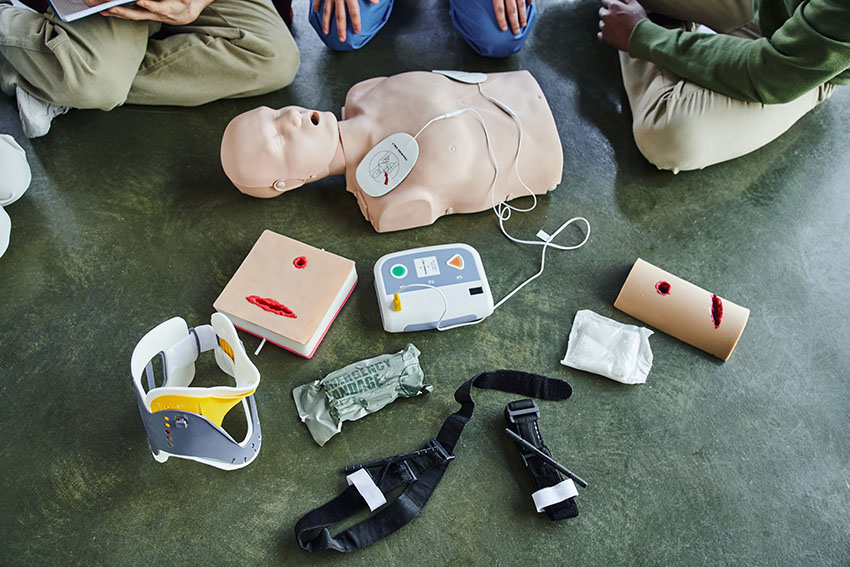Safe Use of Tourniquets, What Every Parent Needs to Know by Steven Sund
Having been in law enforcement for 30 years and a parent for all but six of those,
one of my top recommendations to parents behind seatbelt safety, CPR, and the
The Heimlich maneuver is to own and know how to use a tourniquet. To some, the term “tourniquet” evokes images of a precarious sanguine object used by medics on a faraway battlefield. To others, it conjures up images of some old episode of the TV show Emergency, where a doctor with a stern look on his face approaches a family in the waiting room and says, “I am sorry, your son lost his leg. They left the tourniquet on too long.” Rather than seeing tourniquets as inaccessible objects that will do more harm than good, we need to start keeping them in our basic first-aid kits and not be afraid to use them.
Only ill-informed people believe that placing a tourniquet on an extremity to cut off blood flow will result in subsequent amputation. According to the Mayo Clinic, most civilian uses of tourniquets are only in place for less than two hours, or the time it takes to transport a patient to a medical care facility. Blood restriction usually takes 4-6 hours to cause harm to an extremity. When I talk to parents about tourniquets, I still get the same responses, “I don’t know how to use one of those,” or “Isn’t that something only trained professionals use?” My answer is to take a few minutes and learn how to use a tourniquet. A person can bleed out in minutes, depending on where the hemorrhage is. If someone is bleeding profusely, you need to stop the bleed! Bleeding is the #1 cause of death after injury. Stopping the bleeding is the most important thing you can do to save a life!
Tourniquets have been used since the 4th century BC. Militaries worldwide have been using them for centuries. More recently, in a study during the wars in Iraq and Afghanistan, there was an incredible 92% survival rate for service members and civilians who had tourniquets applied to their extremity wounds. However, not a single person survived an uncontrolled extremity hemorrhage when no tourniquet was utilized[1]. That’s a 100 percent mortality rate! While these statistics seem shocking, they only reinforce the importance of knowing how to apply a tourniquet and stop the bleeding.
Outside war zones, injuries involving motor vehicle accidents, farm equipment, power tools, and mishaps involving plate glass windows, doors, mirrors, sharp tools, and objects are prevalent sources of injuries resulting in wounds to extremities that can cause significant blood loss.
Learn how to apply a tourniquet in the event of an emergency
The Stop the Bleed campaign has an excellent interactive online course (CLICK HERE) that parents can quickly complete[2]. In addition, the Department of Homeland Security has also made the basic tourniquet application technique from this program available in an easy-to-follow poster (CLICK HERE) [3].
Different types of tourniquets are available for purchase to the consumer, and they all generally do the same thing. A commercially available tourniquet is often made of a nylon strap with a buckle that allows it to be affixed around a limb and cinched by pulling the excess strap through the buckle or with Velcro. The tourniquet is then further tightened by twisting a windlass, a short rod affixed to the strap, significantly tightening the strap around the limb and restricting blood flow. The most common are the Combat Application Tourniquet (CAT) or Soft-T tourniquet. They are inexpensive and can be purchased online or at camping and outdoor stores. Tourniquets are small and can easily be carried in a purse, a briefcase, or a backpack. I take one in my backpack and computer case and keep one in all our vehicles. If you encounter a situation requiring a tourniquet and do not have one, other options can be utilized in an emergency. You can also use a belt, a robe tie, a necktie, a dog leash, an electrical cord, or non-elastic strap. Anything you can tie around an extremity and sufficiently tighten can be used as a tourniquet. Although studies have shown that improvised tourniquets may be less effective or fail more frequently than commercially available ones, in an emergency, something is better than nothing.
Do your best to stay calm and don’t panic. Panicking only wastes precious time and is likely to increase the heart rate of the injured person, resulting in even more blood loss. This situation is the opposite of what you want. Trust me, I know that seeing someone injured and losing a lot of blood is going to freak you out, especially if it is a family member. You need to calm them, call 911, and move to stop the bleeding as quickly as possible by applying pressure to the wound and, if appropriate, using a tourniquet. Tourniquets can be applied over light clothing. Thick or bulky clothing should be removed. It is common for the injured to feel pain or discomfort when a tourniquet is used correctly. The tourniquet needs to be tight to control the bleed sufficiently. Some errors people experience when applying a tourniquet include placing it in the wrong location, making the strap or band too loose, or removing the tourniquet too soon. Once used and the bleeding has been slowed or stopped, only a trained medical provider should remove the tourniquet. If the injury is in a location that is not appropriate for a tourniquet, call 911 and immediately apply direct pressure to the wound to try to reduce the amount of blood loss. You can also use a tourniquet on yourself. If you are injured and bleeding from an extremity, don’t panic. Your mantra needs to be, I WILL SURVIVE! Stay calm and look for a tourniquet or something else that may suffice. Proper action improves your odds!
Tourniquets are easy to learn how to use and can be a lifesaver. But like any learned skill, take the opportunity to refresh your awareness of how to use them and where they are kept. Take a couple of minutes three or four times a year to pull out a tourniquet and review the steps on how and when to apply it. This practice will keep things fresh in your mind so that when you are faced with a severe injury, you don’t panic and can immediately go into response mode and start considering ways to help yourself or others. Tourniquets improve the odds. ❦
Resources
https://www.stopthebleed.org
https://www.dhs.gov/sites/default/files/publications/STB_Applying_Tourniquet_08-06-2018_0.pdf
https://www.mayoclinic.org/medical-professionals/trauma/news/the-crucial-role-of-tourniquets-in-trauma-care/mac-20531726
[1] https://www.ncbi.nlm.nih.gov/books/NBK535393/
[2] https://www.stopthebleed.org
[3] https://www.dhs.gov/sites/default/files/publications/STB_Applying_Tourniquet_08-06-2018_0.pdf
 About the Author
About the Author
Steven Sund is a thirty-year law enforcement veteran, author, and adjunct instructor. Sund served for over 25 years with the Metropolitan Police Department in Washington DC where he rose through the ranks to become the commander (Deputy Chief) of the elite Special Operations Division.
After a brief retirement, he joined the United States Capitol Police (USCP).
He was appointed the tenth Chief of Police for the USCP in 2019.
